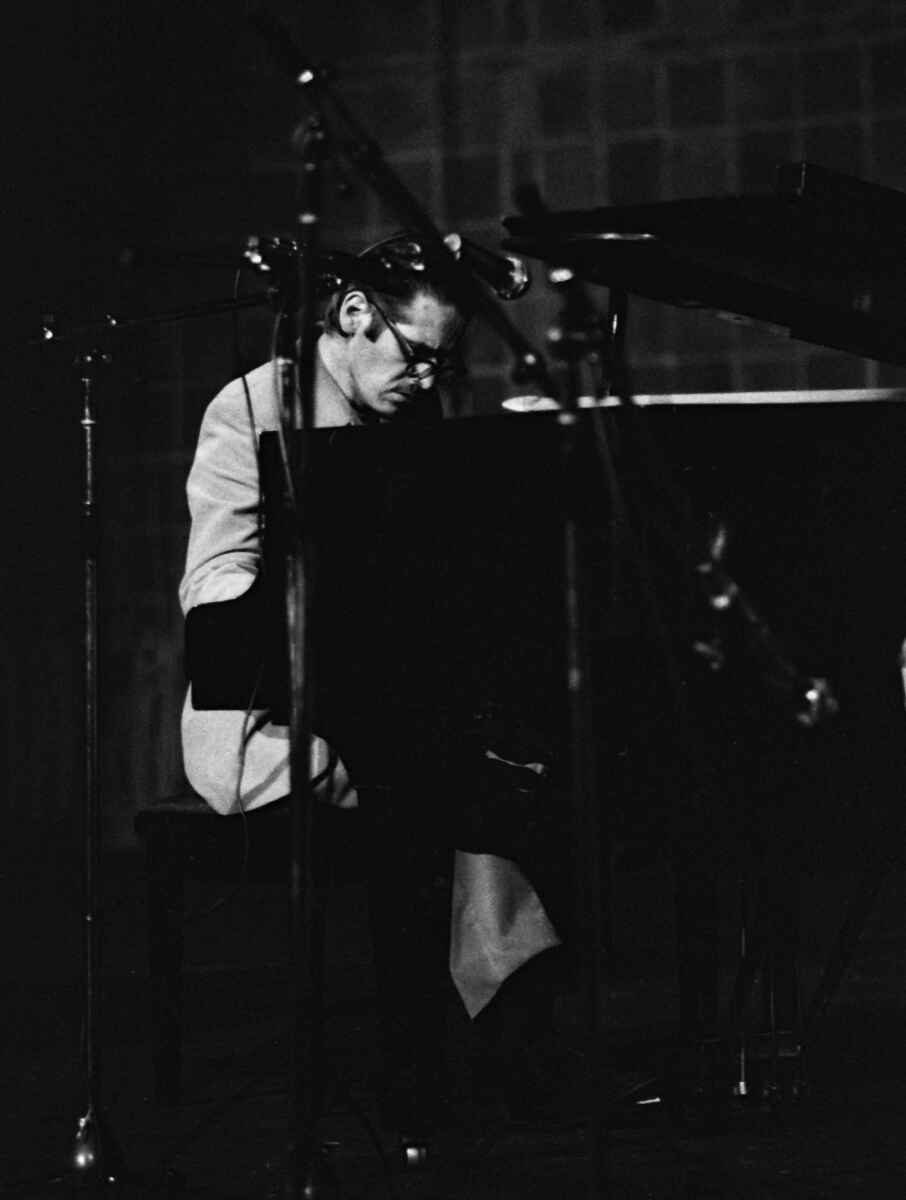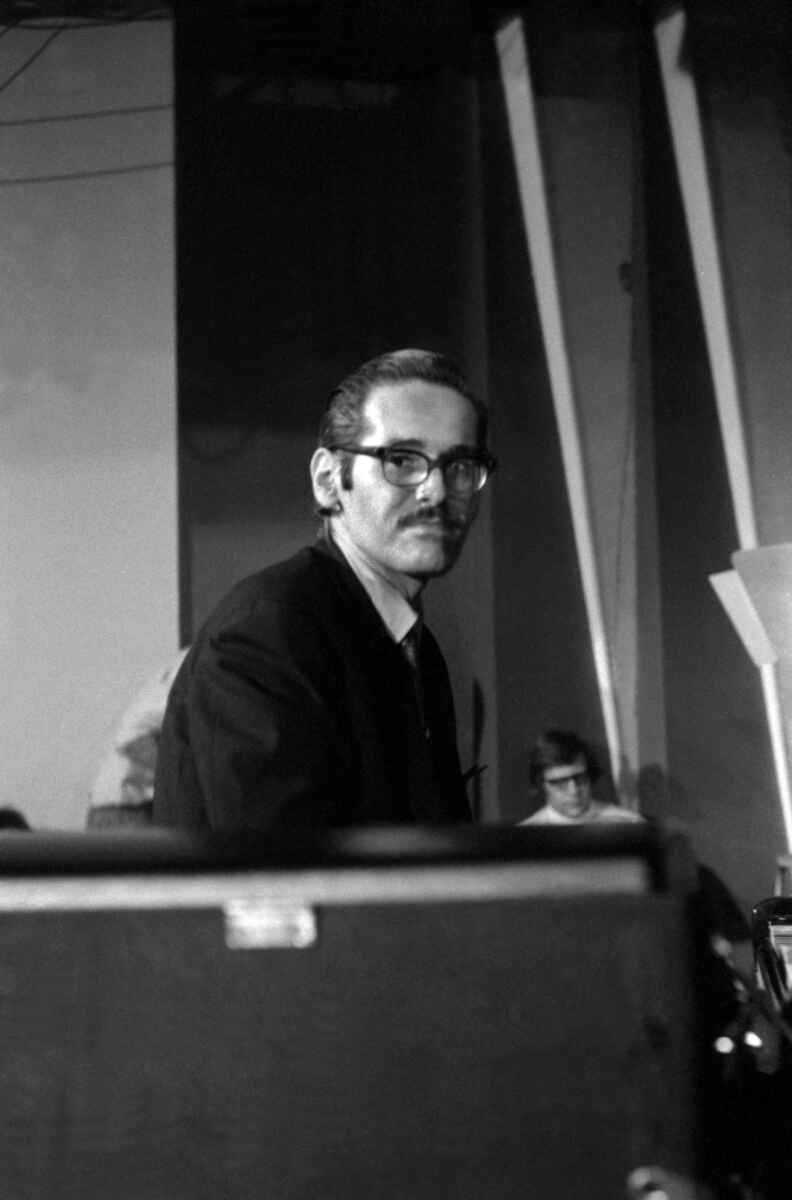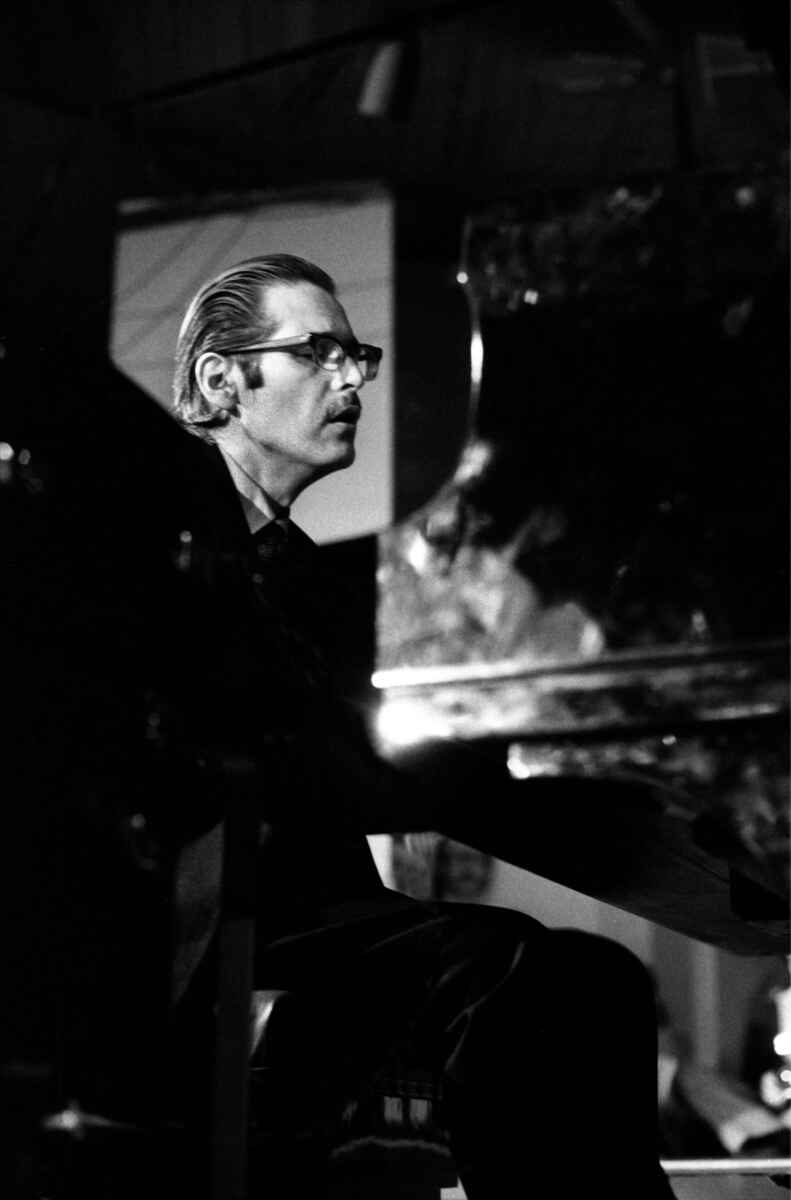
On June 26, 1970 the jazz pianist and composer Bill Evans (August 16, 1929 – September 15, 1980) played with his trio—Eddie Gomez (*1944) on bass and Marty Morell (*1944) on drums—at the Kongsberg Jazz Festival in Norway.
In the liner notes of the concert recording, Marc Myers writes that, at the start of 1970, Bill Evans had begun to wean himself off his notorious heroin habit by enrolling in a supervised methadone program at New York’s Rockefeller University. Long known for his withdrawn, sullen perch at the piano—a mood brought on by his heroin use—Evans on methadone was more animated. He played piano with a newfound alacrity. On methadone, there was an element of elation tugging Evans forward.
Eddie Gomez had joined the Bill Evans Trio in 1966, at age 21, and Marty Morell came aboard in 1968, at age 24. Together, they played with conversational warmth and sensitivity, but on tour, their downtime was solitary.
Marty Morell recalled: “In Norway in 1970, as with nearly every tour stop, we never did any sightseeing. We were boring, man. We just didn’t get into the tourist thing at all. After we arrived at our hotel, Eddie and I shared a room and wouldn’t see Bill until we were about to leave for the gig. Bill kept to himself. He was like the Phantom. He preferred to be alone. We also never talked about the music.”
Just before a concert or club gig would start, as the trio took the stage, Marty Morell said Bill Evans typically played a figure of three or four notes for Gomez to tune. “That brief figure was pure Bill. If there was noise in the audience, those notes settled everyone down and set the mood for the entire set.”
Bill Evans in Norway: The Kongsberg Concert. Elemental Records, 2024 (live recording from 1970). Bill Evans on piano, Eddie Gomez on bass, Marty Morell on drums. Accept cookies—we receive a commission, price unchanged—and order the CD or Vinyl from Amazon.com, Amazon.co.uk, Amazon.fr, Amazon.de.

Bill Evans. Photo copyright © Arthur Sand.
On June 26, 1970 Bill Evans on piano, Eddie Gomez on bass and Marty Morell on drums kicked off the Kongsberg Jazz Festival concert with “Come Rain or Come Shine”, a Harold Arlen standard from 1946 and part of Evans’s repertoire since his 1960 album Portrait in Jazz. After a calm start, it offered Eddie Gomez the possibility to shine on bass in a solo passage. The trio’s interpretation is pleasing, entertaining and flowing.
According to Marc Myers, interesting is how Bill Evans reharmonized the song. This version is particularly striking with his removal of the melody from the top notes of the chords in the first six bars. Instead, he uses intriguing substitutions, predominately 9ths and 13ths that widen the feel and add a lightness. Marty Morell told Marc Myers “Evans liked opening concerts with this song or ‘Very Early’ to snap the trio into place.”
The second tune of the evening was Michel Legrand’s “What Are You Doing the Rest of Your Life?”, written for the 1969 film The Happy Ending by Richard Brooks. Despite the song being only a year old, the trio had been playing it extensively on tour, most notably on Bill Evans: Evans in England, recorded in December 1969, on the album From Left to Right in March 1970 and at the Village Vanguard in April, which was included years later on the Secret Sessions box. It’s a calm, introspective film music.
Third came the evening’s first composition written by Bill Evans himself, “34 Skidoo”, which he had first recorded for his Moon Beams album in 1962, but Riverside producer Orrin Keepnews held it back in favor of other tracks, eventually releasing it only on the 1977 LP The Second Trio on Milestone. The faster paced, elegant, uplifting rendition at the Kongsberg Jazz Festival is convincing.
Bill Evans in Norway: The Kongsberg Concert. Elemental Records, 2024 (live recording from 1970). Bill Evans on piano, Eddie Gomez on bass, Marty Morell on drums. Accept cookies—we receive a commission, price unchanged—and order the CD or Vinyl from Amazon.com, Amazon.co.uk, Amazon.fr, Amazon.de.

Bill Evans. Photo copyright © Arthur Sand.
“Turn Out the Stars”, another Evans original, came fourth. According to Marc Myers, it was commonly played in a maudlin mode. In Norway, after a calm start, a subdued mid-tempo run-through, the pace quickens, shifting to a more happy-go-lucky tempo. Marty Morell’s brushes are particularly elegant, the music in general is optimistic, uplifting.
“Autumn Leaves” is the English-language version of the French song “Les Feuilles mortes” (“The Dead Leaves”), composed by Joseph Kosma in 1945, with French lyrics written by Jacques Prévert. The instrumental rendition by the Bill Evans Trio in Kongsberg takes off like a rocket. After the lively start follows calmer bass solo by Eddie Gomez, with Marty Morell feeding him a cozy collection of cymbal figures.
Denny Zeitlin’s elegant ballad “Quiet Now”, which he wrote in college in the late 1950s, is the masterpiece on Bill Evans in Norway: The Kongsberg Concert, according to Marc Myers. It opens hushed and measured and builds majestically. Then Bill Evans uses a cascade of chords to transition to a faster tempo. The song skips along with delicate perfection, and Evans reverts to block chords halfway in to return to a slower tempo for the lengthy outro. For Marc Myers, this is Evans’s most glorious version of the song, which can obviously also be found on the 1970 Bill Evans Trio album Quiet Now, recorded with Eddie Gomez and Marty Morell.
Marc Myers sent the track along to Zeitlin for his thoughts: “While I’ve never pulled together all of Bill’s ‘Quiet Now’ versions to compare them, this one is my favorite, too. The essence is the level of relaxation; even as he develops his solo into faster and more complex figures, the music doesn’t sound rushed or cluttered. In this version, he sounds totally confident—a man who knows the terrain and has myriad choices and plenty time for them. I also very much like the arch shape of the arrangement.”
The seventh track on the album is Miles Davis’s “So What”. It was a common change-up choice for the Bill Evans Trio during this period. In addition to Evans’s 1959 recording with the Miles Davis Sextet in 1959 for Kind of Blue, the trio had already recorded the song in 1969 on What’s New, with flutist Jeremy Steig; during a summer tour stop in Pescara, Italy; and at Ronnie Scott’s jazz club on the album Evans in England. The Kongsberg concert interpretation is lively, Evans plays with commitment. For me, it’s as good as “Quiet Now”.

Bill Evans. Photo copyright © Jak-Kilby, ArenaPAL (at the Montreux Jazz Festival 1970).
Track number 8 is “Gloria’s Step”, composed by bassist Scott LaFaro in the late 1950s. The pianist Don Friedman, LaFaro’s roommate at the time, told Marc Myers in a 2009 interview, “Scotty wrote it for his girlfriend, Gloria, a dancer. But the song’s title originated because he knew the sound of her footsteps coming up the stairs to the apartment, not because she was a dancer.” The music is streamlined and moves swiftly. The piano play is outstanding.
“Emily” opens like a fresh breeze, with Bill Evans on solo piano. As the waltz builds with precision, Eddie Gomez and Marty Morell slide in quietly and the Johnny Mandel movie theme swings gracefully. “Emily” offers tempo variations: pleasing, then brisk, then frenzied, then calmer again towards the end.
Joe Zawinul’s “Midnight Mood” was first recorded by Bill Evans in 1968 on his solo album Alone. Marc Myers underlines that it starts here abruptly to extinguish the audience’s applause. Once Evans senses that the song is moving too quickly, he reels in the tempo slightly. I noted that the piano shines, the rendition is pleasant and optimistic.
On track number 11, “On Who Can I Turn To?”, Bill Evans dispenses with the ascending introduction he first made famous on the album Bill Evans at Town Hall in 1966. Instead, the standard is taken a bit fast, abandoning the song’s original sentiment about not knowing who to turn to when on one’s own. Following Eddie Gomez’s bass solo, Bill Evans pecks his way along with Marty Morell on brushes. The piano playing is warm and with power. According to Marc Myers, there’s even a sly tag of Jumpin’ With Symphony Sid in two different keys. At the end, after Evans takes a glorious swan dive to end the song.
Track number 12, Leonard Bernstein’s “Some Other Time”, is rendered with patience and remains restrained until the mid-point, where the tempo is doubled. The ending is calm again.
The last track, “Nardis” must have been an encore number, since the audience’s rhythmic clapping seems designed to lure the trio back on stage for one more. Bill Evans opens the Miles Davis composition as a dark search for meaning. The drummer gets his moment of glory and, I agree with Marc Myers, Marty Morell is spectacular, rolling out everything he has with thunderous elegance.
Bill Evans in Norway: The Kongsberg Concert is one of Evans’s finest live recordings, complete with several unbeatable versions. Marty Morell told Marc Myers: “Bill was always in the moment. We all were, and performances really took it out of us. The music may seem to have poured out of us automatically, but that’s not the case. Everything you hear was created in the moment. Bill put his heart on stage and opened himself up completely. He had the ability to hypnotize an audience.”
Bill Evans in Norway: The Kongsberg Concert. Elemental Records, 2024 (live recording from 1970). Bill Evans on piano, Eddie Gomez on bass, Marty Morell on drums. Accept cookies—we receive a commission, price unchanged—and order the CD or Vinyl from Amazon.com, Amazon.co.uk, Amazon.fr, Amazon.de.

Bill Evans. Photo copyright © Jak-Kilby, ArenaPAL (at the Montreux Jazz Festival 1970).
Eddie Gomez said regarding the concert: “When we played in Kongsberg, we had just played at the Montreux Jazz Festival in Switzerland. The recording of that event was called Montreux II. And at that time Montreux was a very high-profile festival. Having passed that hurdle, we went on to Kongsberg, and that was a relief. I felt really relaxed, like, ‘Okay, this is good. It’s not like Montreux, there’s less pressure.’ And I think the outcome is a record that’s quite good.”
Marty Morell added: “There’s nothing like playing jazz in Europe — Norway, Scandinavia. Bill was loved, and it was always a special treat, and an honor really, to play for those people, because he was appreciated so well. But then you go to Paris and London and other countries, and it was a similar vibe. And South America, too. Bill was revered all over the world.”
This never-before-released album is a joy to listen to. The booklet includes a Bill Evans interview by Randi Hultin in Kongsberg made on June 27, 1970 as well as reflections by Eddie Gomez, Marty Morell, Roy Hellvin, Craig Taborn and Aaron Parks on Bill Evans. Most helpful were Marc Myers remarks.
Bill Evans in Norway: The Kongsberg Concert. Elemental Records, 2024 (live recording from 1970). Bill Evans on piano, Eddie Gomez on bass, Marty Morell on drums. Accept cookies—we receive a commission, price unchanged—and order the CD or Vinyl from Amazon.com, Amazon.co.uk, Amazon.fr, Amazon.de.

For a better reading, quotations and partial quotations in this CD/Vinyl album review have not been put between quotation marks.
CD/Vinyl album review added on Februry 16, 2025 at 14:15 German time.